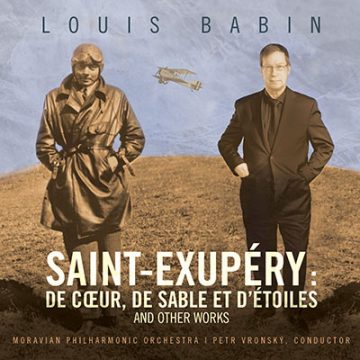SAINT-EXUPÉRY : DE CŒUR, DE SABLE ET D’ÉTOILES AND OTHER WORKS
SAINT-EXUPÉRY : DE CŒUR, DE SABLE ET D’ÉTOILES AND OTHER WORKS
Three works. Three visions. One composer. Life’s heartbeat is everywhere throughout this album. The symphonic poem Saint-Exupéry: de coeur, de sable et d’étoiles is a homage to the creator of Le Petit Prince. Couleurs depicts the longing of adolescence. La Suite du promeneur, shares a philosophic vision of mankind’s passage here on earth …Louis Babin spins out a multi-layered musical Ariadne’s Thread for you to follow – or to lose yourself within…
buy now
album detail
Saint-Exupéry : de cœur, de sable et d’étoiles (17’38”)
(Saint-Exupery : of Heart, Sand And Stars)
Orchestra
- Vol de vie (A Stolen Life)
- Les adieux au Petit Prince (Farewell To The Little Prince)
- La marche des Hommes (The March of Humankind)
Couleurs (5’47”)
Strings
La Suite du promeneur (9’18”)
Strings
- Le curieux
- L’extase
- La tentation
- Aux portes de l’enfer
- La morale de cette…
Moravian Philharmonic Orchestra conducted by Petr Vronský
Great reviews
Letter to Philippe de Saint-Exupéry,
nephew of Antoine and founder of the Fondaton Antoine de Saint-Exupéry pour la jeunesse.
When M. Claude Révolte, President of the Fédération des festivals Eurochestries, informed me in mid-January that the theme for the festival held in Charente-Maritime would be Antoine de Saint-Exupéry, people close to me were wondering how I could meet the challenge of composing a symphonic work based on this imposing figure. As for me, I had no idea how the work awaiting would immerse me in a universe totally new and at the same time very familiar. At pre-school I was entranced by Le Petit Prince – both the book and the recorded enactment featuring the voice of Gérard Philippe. This was not a tale like others. The story left a strong and lasting mark on the soul without one’s reason grasping all its subtleties. When I was an adolescent, I read Vol de nuit (Night Flight) and Pilote de guerre (Flight to Arras). These books took their place in a body of work that fed my insatiable appetite for authors such as Balzac, Stendhal, Hugo, Miller, Durrell and several others. Because he was describing his own comrades and experiences, Saint-Exupéry had a direct and honest quality of writing that was somehow different. He related his adventures and those of his companions from a point a view that exalted Man and his essential values: responsibility, cooperative support, love of one’s fellows.
But that world was now remote from the life I was leading. Over the years, my work as a trumpeter and a composer left me less time to read and Saint-Exupéry grew less present in my thoughts. I quickly realized that in order to prime my own writing process, I had to renew my acquaintance with his work. That included Lettre à un otage (Letter to a Hostage). Once back into it, I was amazed! It was the density of the writing. Not one word wasted. You could take any sentence at random and find depth, impact and significance.
I was not content just to read and re-read all his books. I set about gaining a better understanding by reading biographical articles and information posted on the official website dedicated to Saint-Exupéry. I read with astonishment the trove of material surrounding the mystery of his disappearance. I spent time learning the history of the Latécoère de l’Aéropostale company, acquiring a deeper sense of the life of these pioneers of aviation and their shared code: the comradery, an instinct for survival, their solitude, but also their solidarity. I began to understand how Saint-Exupéry’s consistent and powerful daily writing derived its strength from the immense quantity of pages he amassed relentlessly over the course of his days, followed by editing to extract the essence, ultimately yielding a text of rare density from which all extraneous embellishment was removed.
Voilà, my challenge: to express in music the life of this man and his thinking.
I realized three strong thematic lines would be required: The pilot. The Little Prince. The humanist. Of course the writer is present in each of these elements. These concepts would be the basis of three movements of the symphonic work, which would ultimately be about 15 or 16 minutes in duration.
I – Vol de vie (A Stolen Life)
The first movement is built around the disappearance of Saint-Exupéry the pilot. For me, the trumpet represents the noble character and courage of this man. The musical portrait reflects his way of writing: his factual descriptions interspersed with philosophical flights build to an intense immersion in his memories of past reconnaissance missions. Suddenly, in the midst of the tumult, the writer’s thinking breaks free and looks clearly and lucidly at the destiny of men and the fate of nations, and the contradictions set against each other. But this episode of drifting in time is brought back to the reality of combat, which unfolds under the shroud of mystery surrounding the pilot’s untimely disappearance. Thus the title of this first movement: A stolen life.
II – Les adieux au Petit Prince (Farewell To The Little Prince)
One thing was clear to me: The disappearance of Saint-Exupéry the pilot coincided with the publication of Le Petit Prince. And at the end of the book the Little Prince also leaves the planet with the help of the serpent. Meanwhile, it’s a German aviator who will make the same thing happen to Saint-Exupéry the author. Thus we have a thematic meeting point seamlessly joining the first movement with the second. While the finale of the first movement implies the plane vanishes without a trace, the plane returns in another form to the sound of bullroarers and singing dunes, to where we meet the Little Prince in the middle of the desert. This movement is a private conversation between the pilot and the child, a practical man confronting his philosophical side. The meeting occurs in the desert, far from any civilization. But this desert, despite its barren appearance, is a fertile land of imagination and magic. The Little Prince recounts his journeys and encounters in the cosmos, then he recalls his flower, his rose whom he left behind. And so the aviator will be witness to the Little Prince’s meeting with the serpent, who sends him into space with the ultimate kiss…
III – La marche des Hommes (The March of Humankind)
The pilot and his little gentleman – his philosophical alter ego – did not leave us in vain. Their spirit lives and still inspires those who take the time to read and listen to them. Thus a march commences. It begins with only a few men and women, then grows as others join them, united by the humanist thinking of Saint-Exupéry and the ideas flowing from it. It is not a religion. Rather, it is an invitation to each person to follow in one’s own way of life. And to carry like a standard at the head of this never-ending march, this citation: ‘Your task is not to foresee the future, but to enable it.’
To conclude
Saint-Exupéry inspired the form, melodies, rhythms and thoughts informing this symphonic work. The piece is unique in that it was composed for, and will be performed by, young musicians of diverse nationalities, aged 15 to 25, who, as it happens, come from countries visited by Saint-Exupery either as a pilot or a journalist. For me, this a special juncture in my musical career. When I decided to put aside the trumpet in order to focus on composing, my first commission was a piece commemorating the 40th anniversary of Expo67, whose theme was Man and His World!
I am aware of how fiercely Saint-Exupéry’s heirs guard his reputation and the caution they exercise in selecting projects proposing the use of his name and works. I understand and respect this. However, I am convinced the association of his name, and that of Le Petit Prince with this musical work created for youth, and which speaks equally to adults, will be a proud and dignified ambassador of the values and goals set out by the Antoine de Saint-Exupéry Youth Foundation.
Louis Babin, composer
Samedi 7 juillet 2012, Laval, Québec
Donation to the FASEJ
By purchasing this album, you are supporting the initiatives of the Antoine de Saint-Exupéry Foundation in favour of the education of disadvantaged youth.



